Introduction: The Carmelite Painter
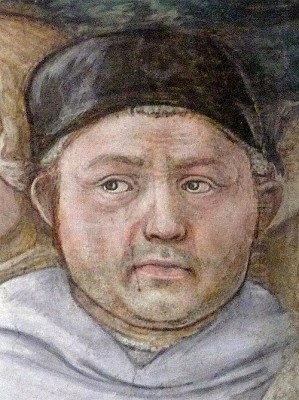
Fra Filippo Lippi stands as one of the most fascinating and significant painters of the Early Italian Renaissance. Active primarily in Florence during the vibrant Quattrocento (15th century), Lippi's life (c. 1406–1469) was a compelling narrative of artistic genius intertwined with personal scandal. Orphaned at a young age and placed in a Carmelite monastery, his path seemed destined for religious devotion. Yet, his undeniable talent for painting, coupled with a notoriously amorous nature, led him down a different, more tumultuous road. His art, deeply influenced by masters like Masaccio but infused with his own lyrical grace and human warmth, bridged the gap between the sacred and the secular, leaving an indelible mark on Florentine art and influencing generations of artists to come, including his most famous pupil, Sandro Botticelli.
Early Life and Carmelite Beginnings
Born around 1406 in Florence, Filippo was the son of Tommaso Lippi, a butcher. Tragedy struck early; his father died when Filippo was very young, and his mother passed away soon after. Left an orphan, he was placed under the care of his paternal aunt, Mona Lapaccia. However, resources were scarce, and by the age of eight, around 1414, Filippo and his brother were entrusted to the nearby Carmelite monastery of Santa Maria del Carmine. This institution would become his home and school for many years.
Inside the monastery walls, Filippo took religious vows around 1421, becoming "Fra" (Brother) Filippo. While records suggest he showed little aptitude for traditional academic studies, his talent for drawing was unmistakable. Giorgio Vasari, the famed 16th-century biographer of artists, recounts that instead of studying, the young Lippi would fill his books and those of others with sketches. The priors, recognizing his innate gift, wisely decided to encourage his artistic inclinations and provided him with opportunities to learn the craft of painting.
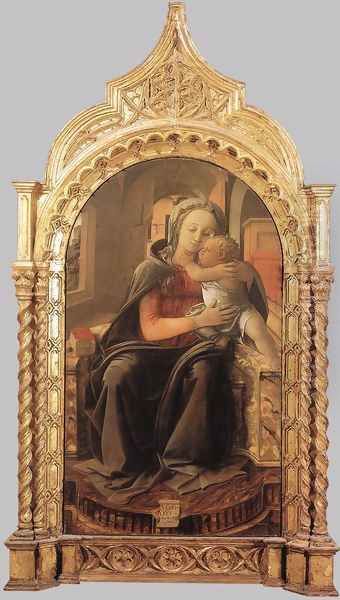
The Santa Maria del Carmine church itself proved to be a crucial classroom. During Lippi's formative years there, the Brancacci Chapel within the church was being decorated with groundbreaking frescoes by Masaccio and his collaborator Masolino da Panicale. These works, with their revolutionary use of perspective, realistic depiction of human anatomy and emotion, and dramatic handling of light and shadow (chiaroscuro), were a revelation. Lippi spent countless hours studying these frescoes, absorbing the lessons of Masaccio's powerful naturalism. This early exposure profoundly shaped his artistic vision.
Developing a Unique Style
While Masaccio's influence is evident in Lippi's early works, particularly in the solidity of his figures and his grasp of perspective, he soon began to forge his own distinct artistic identity. He moved away from Masaccio's stark monumentality, developing a style characterized by a greater emphasis on decorative beauty, linear grace, and a more intimate, humanized portrayal of religious figures. His work often shows a delicate interplay of light and color, creating a softer, more lyrical atmosphere than that found in Masaccio's paintings.
Another significant, though perhaps less direct, influence was Fra Angelico, a Dominican friar and painter renowned for his pious, brightly colored, and spiritually radiant works. While Lippi's art possessed a more worldly quality, he seems to have absorbed some of Fra Angelico's sweetness and decorative sensibility, blending it with Masaccio's realism. This fusion resulted in a style that was both grounded in observation and elevated by a sense of grace and charm.
Lippi excelled in the use of tempera paint on wood panels, achieving subtle modulations of color and fine detail. His Madonnas, often depicted with tender, youthful beauty and adorned in elegant contemporary attire, became particularly popular. Works like the Tarquinia Madonna (1437) showcase his growing mastery, revealing a delicate modeling of form and a gentle, introspective mood that would become hallmarks of his style. He demonstrated a remarkable ability to convey subtle human emotions, making sacred figures feel relatable and accessible.
The Master's Hand: Major Commissions and Works
Fra Filippo Lippi's talent did not go unnoticed, and he began receiving important commissions both within Florence and in other Italian cities. His reputation grew steadily, despite his often-unconventional behavior. He worked for prominent families, including the powerful Medici, and for various religious institutions.
One of his early significant commissions was the Barbadori Altarpiece, likely begun around 1437 for the Barbadori family chapel in the church of Santo Spirito, Florence. Now housed in the Louvre (main panel) and the Uffizi (predella panels), this work shows the Virgin and Child enthroned, flanked by angels and saints. It clearly demonstrates Lippi's ability to organize complex compositions and his growing interest in decorative detail and elegant figure types.
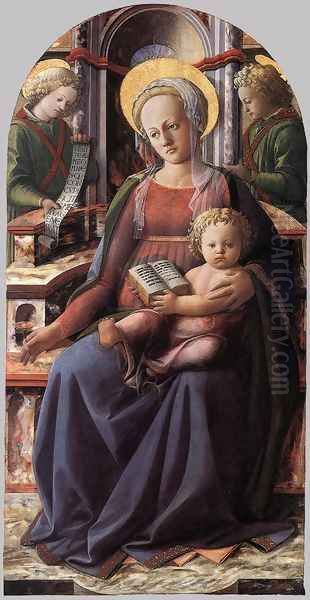
Perhaps Lippi's most celebrated works are the fresco cycles he painted in the main chapels of the cathedrals of Prato and Spoleto. Between roughly 1452 and 1465, he decorated the choir of Prato Cathedral with scenes from the lives of St. Stephen and St. John the Baptist. These vibrant frescoes are renowned for their dynamic compositions, lively narrative detail, convincing spatial depth, and depictions of figures in elaborate, fashionable contemporary dress. The dancing Salome in the Feast of Herod scene is a particularly famous example of Lippi's graceful linearity. It was during his time in Prato that his most notorious personal scandal unfolded.
Later in his career, from around 1467 until his death in 1469, Lippi worked on frescoes depicting scenes from the Life of the Virgin in the apse of Spoleto Cathedral. These works, completed with the help of assistants including his son Filippino and Fra Diamante, represent the culmination of his fresco technique. The Coronation of the Virgin in the apse vault is particularly majestic, showcasing his skill in complex foreshortening and celestial composition.
Lippi was also a master of panel painting. His Coronation of the Virgin (c. 1441-1447), commissioned for the church of Sant'Ambrogio in Florence and now in the Uffizi, is a complex and bustling composition filled with saints, angels, and portraits of contemporaries, including a supposed self-portrait. He painted numerous variations of the Madonna and Child, often placing the figures in domestic settings or against landscape backgrounds, further humanizing the sacred subject. A notable example is the Madonna and Child with Two Angels (Uffizi, c. 1465), where the playful angels support the Christ Child, and the Madonna possesses a portrait-like quality, possibly modeled after Lucrezia Buti.
Lippi also contributed to the popularity of the tondo, or circular painting format, often used for domestic devotional images. His Bartolini Tondo (Madonna and Child with scenes from the Life of the Virgin, c. 1452-1453) is a prime example, skillfully adapting the composition to the challenging circular shape. This format would later be embraced by artists like Botticelli and Raphael. Another celebrated work often attributed to this period is the Adoration in the Forest (Berlin), a mystical depiction of the infant John the Baptist venerating the Christ Child in a detailed woodland setting, showcasing Lippi's sensitivity to nature and light.
Patrons and Peers
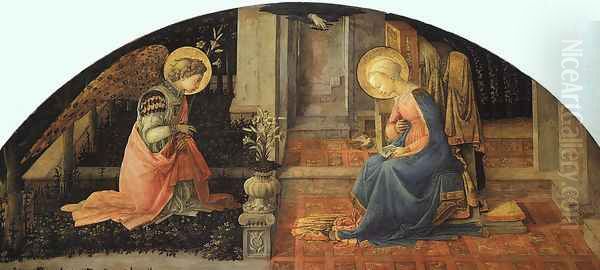
Lippi's career was significantly aided by the patronage of Florence's ruling Medici family, particularly Cosimo de' Medici ('il Vecchio'). Cosimo, a great connoisseur and supporter of the arts, recognized Lippi's talent and provided him with commissions and protection, even intervening during the artist's personal crises. Vasari tells amusing, if perhaps exaggerated, stories of Cosimo locking Lippi up to force him to work, only for the artist to escape down a rope made of bedsheets to pursue his amorous adventures. Despite the painter's unreliability, the Medici continued to support him, valuing his unique artistic contributions. Lorenzo de' Medici ('the Magnificent'), Cosimo's grandson, later commissioned a grand tomb for Lippi in Spoleto Cathedral.
Beyond the Medici, Lippi interacted with various artists and assistants. Fra Diamante was a longtime collaborator who worked closely with Lippi, especially in Prato and Spoleto, and helped complete the Spoleto frescoes after Lippi's death. Francesco Pesellino, another talented Florentine painter, is sometimes described as Lippi's student or collaborator, though Pesellino died relatively young in 1457. Lippi's workshop was a training ground for younger artists.
His most significant pupil was undoubtedly Sandro Botticelli, who entered Lippi's workshop likely in the early 1460s. Botticelli absorbed his master's emphasis on linear grace, elegant figure types, and decorative detail, developing these qualities into his own highly distinctive style. The influence of Lippi is clearly visible in Botticelli's early Madonnas. Lippi's impact extended further, influencing other prominent Florentine artists like Andrea del Verrocchio, the master of Leonardo da Vinci, and Filippino Lippi, his own son, who became a renowned painter in his own right. His work was part of the rich artistic milieu of Florence that included sculptors like Donatello and Lorenzo Ghiberti, and painters like Paolo Uccello and Domenico Veneziano.
A Life of Contradictions: The Lucrezia Buti Affair
Fra Filippo Lippi's life was marked by a profound tension between his religious vows and his worldly desires. This conflict culminated in the most famous scandal of his life: his relationship with the nun Lucrezia Buti. Around 1456, while working on frescoes in Prato and serving as chaplain to the convent of Santa Margherita, Lippi asked the abbess if he could use one of the nuns, Lucrezia Buti, as a model for the Virgin Mary.
According to Vasari, Lippi either abducted Lucrezia during a public procession or persuaded her to run away with him. Regardless of the exact circumstances, the two began a relationship, and Lucrezia bore Lippi a son, Filippino, around 1457, and later a daughter, Alessandra. This affair between a friar and a nun caused a major scandal. Lippi faced accusations of serious misconduct and legal troubles.

His powerful patron, Cosimo de' Medici, intervened on his behalf, appealing to Pope Pius II. Eventually, the Pope granted a special dispensation allowing Lippi and Lucrezia to be released from their vows and marry. However, Vasari claims Lippi preferred the freedom to pursue other relationships and declined to formalize the union, though they continued to live together. This episode highlights the complexities of Lippi's character – a man capable of creating sublime religious art while simultaneously defying societal and religious conventions. Many art historians believe that Lucrezia's features are immortalized in some of Lippi's most beautiful Madonnas from this period, lending them a distinctly human and perhaps portrait-like quality.
Lippi's life was plagued by other issues as well. He faced accusations of fraud and embezzlement related to commissions, leading to lawsuits and further damage to his reputation. His financial affairs seem to have been frequently precarious. Despite these troubles, his artistic talent ensured that commissions continued to come his way.
Anecdotes and Reputation (Vasari's View)
Much of what we know, or think we know, about Lippi's colorful personality comes from Giorgio Vasari's Lives of the Most Excellent Painters, Sculptors, and Architects (1550, revised 1568). Vasari, writing nearly a century after Lippi's death, presents him as a talented but incorrigibly lustful and unreliable character. Vasari recounts the story of Lippi's supposed capture by Moorish pirates off the coast of Ancona during his youth. According to this tale, Lippi was enslaved in North Africa but earned his freedom by impressing his master with a skillful charcoal portrait drawn on a wall. While dramatic, the historical accuracy of this story is highly questionable and may be an invention to explain a period when Lippi's whereabouts are uncertain after leaving the monastery.
Vasari also emphasizes Lippi's constant pursuit of women, detailing Cosimo de' Medici's attempts to manage the artist's escapades. These anecdotes, while entertaining and contributing to Lippi's legend, should be treated with caution. Vasari often relied on hearsay and aimed to create compelling narratives, sometimes sacrificing strict accuracy for dramatic effect. However, these stories do reflect the perception of Lippi as a figure whose life was as vibrant and unconventional as his art. They paint a picture of an artist driven by powerful passions, both artistic and personal.
Later Years and Death in Spoleto
Despite the controversies, Lippi's later career was marked by continued artistic success. His final major project was the decoration of the apse of Spoleto Cathedral, a prestigious commission secured perhaps through Medici influence. He moved his family, including Lucrezia and the young Filippino, to Spoleto around 1467 to undertake the work. The frescoes depicting the Annunciation, Nativity, Death of the Virgin, and Coronation of the Virgin are considered among his masterpieces, showcasing his mature style with its blend of narrative energy, spatial complexity, and lyrical beauty.
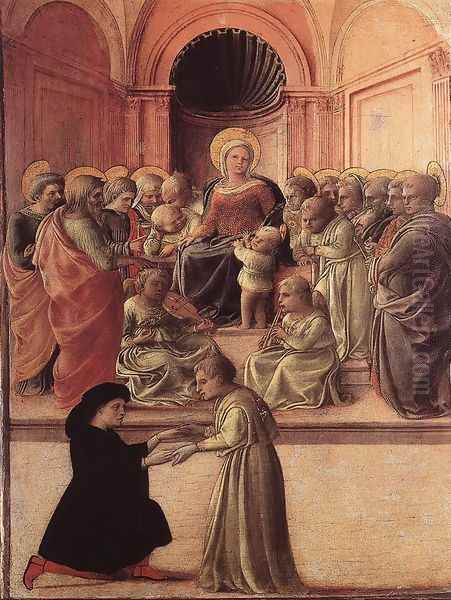
Fra Filippo Lippi died in Spoleto on or around October 8, 1469, before the fresco cycle was entirely finished. His assistants, Fra Diamante and his son Filippino, completed the remaining work. Vasari suggests, rather sensationally, that Lippi was poisoned by the relatives of a woman he had seduced. However, there is no concrete evidence to support this claim, and it is more likely he died of illness.
He was buried within Spoleto Cathedral. Recognizing his importance, Lorenzo de' Medici later commissioned a magnificent tomb for him there, designed by Filippino Lippi himself, ensuring that the Carmelite painter who had lived such a tumultuous life received a burial worthy of his artistic stature.
Legacy and Influence
Fra Filippo Lippi's influence on the course of Italian Renaissance art was profound and multifaceted. He successfully synthesized the monumental realism of Masaccio with the decorative grace and linear elegance that became characteristic of the later Florentine Quattrocento. He humanized religious subjects, infusing them with warmth, tenderness, and relatable emotions, making the divine accessible through familiar human experience. His Madonnas, often depicted as beautiful young Florentine women in contemporary dress, set a new standard for the representation of the Virgin Mary.
His mastery of line, color, and composition deeply impacted his students and contemporaries. His most direct artistic heir was his son, Filippino Lippi, who became a leading painter in Florence, known for his imaginative and sometimes nervously energetic style that bridged the gap between the Early and High Renaissance and anticipated Mannerism. Filippino carried forward his father's linear emphasis and narrative skill.
Sandro Botticelli, perhaps Lippi's most famous pupil, absorbed his master's lyrical line and elegant figure types, transforming them into his own unique and highly poetic vision, evident in masterpieces like Primavera and The Birth of Venus. The influence can also be seen in the works of other Florentine masters such as Andrea del Verrocchio, Francesco Botticini, and later artists who studied the Florentine tradition, including Leonardo da Vinci, Michelangelo, and Raphael, who learned from the innovations in composition, expression, and technique pioneered by Lippi and his generation. Even artists outside Florence, like the Venetian master Titian, explored the tondo format that Lippi helped popularize. His workshop practices and his network of assistants, like Fra Diamante, also contributed to the dissemination of his style.
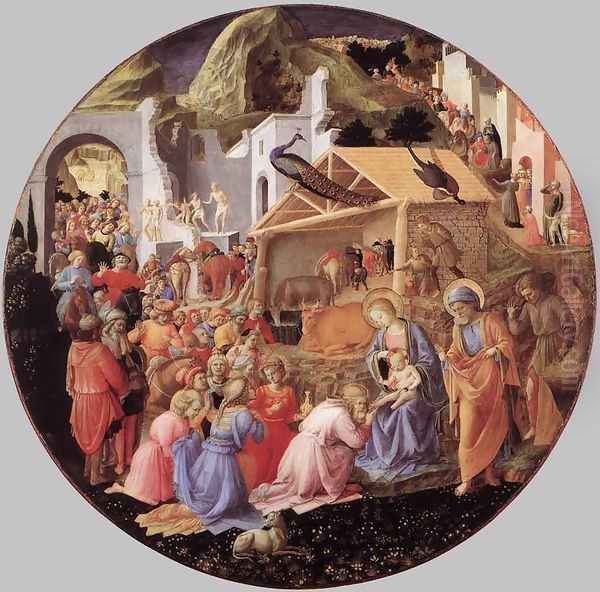
Lippi's innovations in fresco painting, particularly his dynamic compositions and integration of figures within architectural spaces seen in Prato and Spoleto, provided models for later large-scale narrative cycles. His sensitivity to light and landscape backgrounds also pointed towards future developments in Renaissance painting. He remains a key figure in the transition from the early, more austere phase of the Renaissance towards the richer, more decorative, and psychologically nuanced art of the later 15th century.
Art Historical Assessment
Today, Fra Filippo Lippi is universally recognized by art historians as a pivotal figure of the Early Italian Renaissance. He is celebrated for his unique ability to blend piety with a palpable sense of humanity, creating religious art that is both spiritually resonant and deeply engaging on an emotional level. His technical skill, particularly his fluid draftsmanship, sophisticated use of color, and mastery of both fresco and tempera techniques, is highly esteemed.
Art historians emphasize his role in developing a distinctively Florentine linear style, characterized by graceful contours and expressive outlines, which reached its apogee in the work of his pupil Botticelli. He is seen as an innovator in composition, adeptly handling complex multi-figure scenes and popularizing formats like the tondo. His ability to integrate contemporary details, such as fashion and portrait-like features, into sacred narratives is noted as a key aspect of the increasing naturalism and humanism of Renaissance art.
While acknowledging the scandals of his personal life, modern scholarship tends to view these not merely as sensational anecdotes but as integral parts of understanding the artist's complex personality and perhaps even the human warmth evident in his work. The controversies surrounding his relationship with Lucrezia Buti and his financial dealings add a layer of intrigue but do not diminish his artistic stature. He is often described as an artist whose work embodies both earthly beauty and spiritual aspiration. Fra Filippo Lippi remains a testament to the vibrant, complex, and often contradictory spirit of the Florentine Renaissance, an artist whose life and work continue to captivate and inspire.